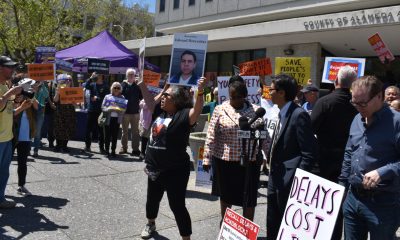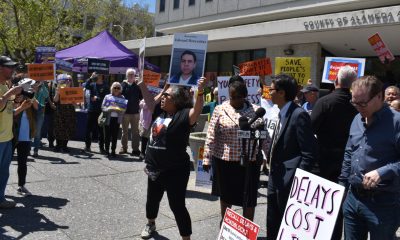California Black Media
Celebrating 50 Years of Hip Hop: Legislative Black Caucus Honors West Coast Greats
The California Legislative Black Caucus (CLBC) and the Recording Industry Association of America (RIAA) celebrated the 5oth anniversary of hip hop on Aug. 14, with a tribute to the West Coast pioneers, leaders and innovators who shaped the genre. The Bring the Peace Movement organized the rally and ceremony where speakers paid homage to the honorees.
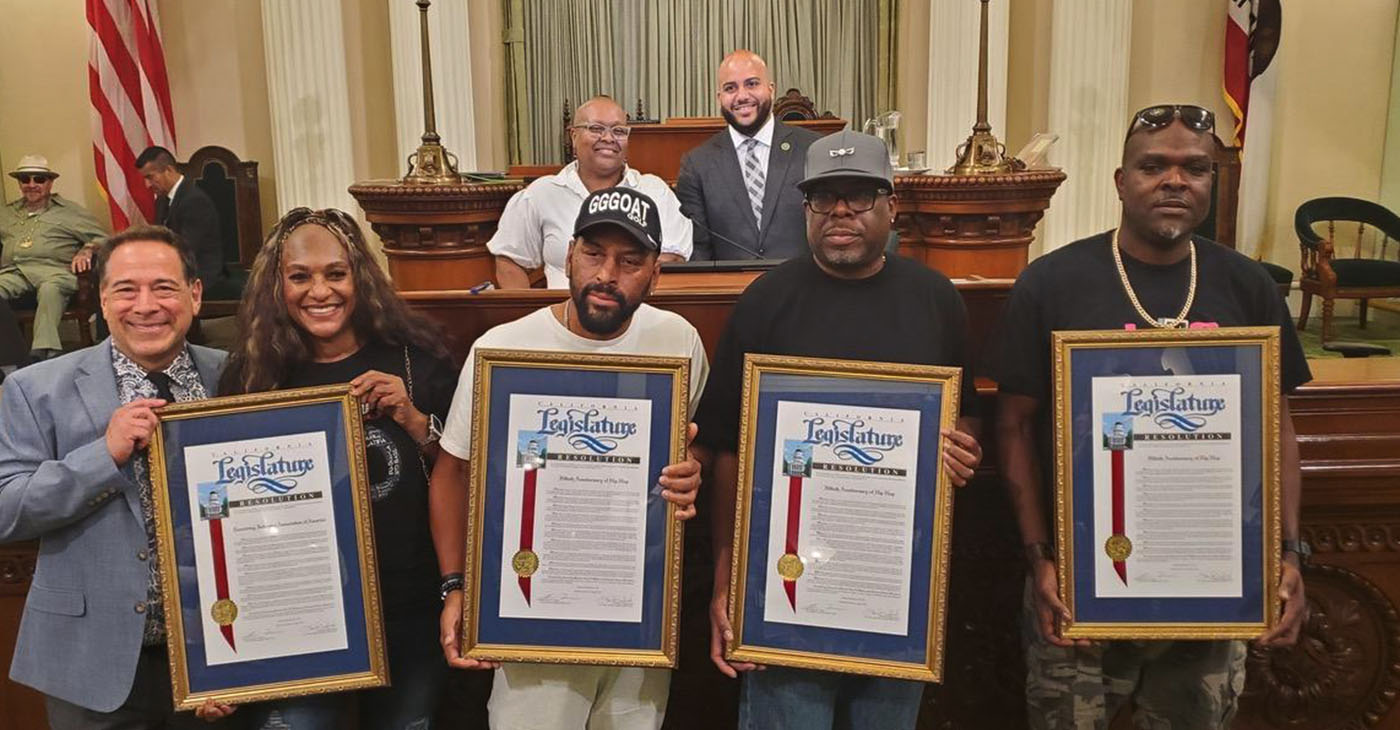
By Antonio Ray Harvey
California Black Media
The California Legislative Black Caucus (CLBC) and the Recording Industry Association of America (RIAA) celebrated the 5oth anniversary of hip hop on Aug. 14, with a tribute to the West Coast pioneers, leaders and innovators who shaped the genre.
The Bring the Peace Movement organized the rally and ceremony where speakers paid homage to the honorees.
Juana Burns-Sperling, co-founder of Rialto/Los Angeles-based all-female hip hop group JJ FAD, told California Black Media (CBM) that the love received from state lawmakers — which included standing ovations on both the Senate and Assembly floors — was a long time in the making, but well worth the wait.
“It was amazing. It was an honor to be there to represent the West Coast and represent my group,” said Sperling, who goes by the stage name, MC JB. “When I first heard about it my thoughts were, ‘finally’ because the West Coast seems to be left out of things that are going on right now. So, the fact that our (lawmakers) were honoring us, we didn’t have to rely on other geographical areas. I was truly happy. We’re finally getting recognized.”
The rap songs Sperling, “Baby D” (Dania Birks) and “Sassy C” (Michelle Ferrens) performed were produced by world-renowned Hip Hop mogul Dr. Dre (Andre Young), and Arabian Prince (Kim Renard Nazel). They group was signed to Ruthless Records.
JJ FAD (an acronym created with the names of the original group members in 1985: Juana, Juanita, Fatima, Anna, and Dana) reached the top of the charts with their signature song, “Supersonic” in 1988.
The program organized by Jamilia Land of the Bring the Peace Movement, featured a voter registration drive and entertainment and was attended by CLBC chair Assemblymember Lori D. Wilson (D-Suisun City), Vice-Chair and Sen. Steven Bradford (D-Gardena) and other officers and members.
“At the time of its founding, hip hop was met with vitriol from politicians. However, today a host of politicians, community organizations and leaders convene to honor the pioneers and architects of the hip hop movement,” Wilson said on the Assembly floor.
Sperling was joined at the State Capitol with West Coast hip hop artists and music producers King T (Roger McBride), Kid Frost (Arturo R. Molina Jr.), Arabian Prince Mistah F.A.B.(Stanley Cox), Micheal Latt, Karega Bailey, Tinish Hollins, Greg Mack, Violet Brown, LaRussell Thomas, Greg Mack, Casual from the Hieroglyphics (Jon Owens), Disco Daddy (Michael Khalfani), filmmaker Deon Taylor, and Alonzo “Lonzo” Williams.
Mickelle “Hayón” Hellon, Leila Steinberg (who was Tupac’s manager), the Magical Rock Band, and retired legislative aid Rory Kaufman were also recognized as honorees.
Known to the West Coast hip hop community as “Grand Master Lonzo,” Williams is the innovator behind the legendary R&B/Rap group “World Class Wreckin Cru,” that found major success with the 1987 hit “Turn Off the Lights.”
“When I called my partner and Senator, Sen. Bradford, and told him we need to do something for hip hop on the West Coast I had no idea that it would end up on the Assembly and Senate floors,” Williams told CBM. “My initial plan was to do something in Compton, get all the homies and OGs together and show some love. But here we are today, and it was a great event.”
Bradford and Williams “go way back” on the music scene of Gardena, Compton, and Los Angeles. They used to promote singing groups, bands, and hip-hop dancing cliques. The artists received a warm welcome from lawmakers in both chambers; thanks to Bradford, Wilson, and Sen. Lola Smallwood-Cuevas (D- Ladera Heights).
“Steve understood what we did back in L.A. back in the day because he was a part of it but only on another level,” Williams said. “Steve was a dance promoter before he became a Compton city councilman, assemblymember, and senator. He was my competition. It just made for a great situation.”
Williams is credited with launching the careers of Dr. Dre, Ice Cube (O’Shea Jackson), D.J. Yella (Antoine Carraby) and Eazy E. (Eric Wright), formerly known as N.W.A. The group is credited with ushering in a form of hip-hop music that was coined gangster rap.
The gangster rap genre propelled the careers of Snoop Dogg (Calvin Broadus Jr.), Nate Dogg (Nathaniel Hale), DJ Quick (David Marvin Blake), Above the Law, Warren G (Warren Griffin III), Lady of Rage (Robin Yvette Allen), Yo-Yo (Yolanda Whitaker), E-40’s (Earl Stevens) little sister Suga-T (Tenina Stevens), among others.
The elements of hip hop culture first emerged in the 1970s in Morris Heights, a neighborhood in the Bronx borough of New York City. Hip-hop consists of four elements: “deejaying,” or “turntabling,” “MCing” or “rhyming,” graffiti painting, and the hip-hop dance, style, and attitude of “B-boying.”
The West Coast artists extracted the characteristics and stylings from East Coast hip hop but were able to create their own musical flavor with stories, references and imagery that reflected street life and living in urban centers, mostly in California.
Gangster rap and the “G-funk era” dominated the hip-hop scene in the late 1980s and all through the 1990s from the Los Angeles region to Oakland/San Francisco Bay Area by standouts like Too $hort (Todd Anthony Shaw).
Joel Flatow, Senior Vice President, Artist and Industry Relations, and Chief of West Coast operations for RIAA, said the accolades bestowed on the artists in Sacramento are a tribute to the innovation and foresight they brought to the culture.
“We just have a tremendous wealth of talent in this state,” Flatow added.
RIAA is a trade organization that supports and protects the rights of artists and music labels in the US.
Adding to the cultural weight to the celebration, Land and other community activists issued a proclamation, offered samplings of poetry, gave shoutouts to hip-hop history, and appealed to the audience to become politically engaged champions of peace.
“This is a time of celebration and reflection,” stated Land, who is also the co-founder of the Anti-Violence, Safety, and Accountability Project (ASAP). “We acknowledge the monumental achievements of West Coast artists and also reflect on the effect of unresolved trauma and violence in the Culture.
California Black Media
Cinco De Mayo: Five Interesting Facts You Should Know About the Popular Mexican American Holiday
To explore the historical significance of Cinco De Mayo, we step back to the origins of the commemoration, share how some Mexican American Californians regard it and trace how it has morphed into the celebrations we see today.

By Edward Henderson, California Black Media
To explore the historical significance of Cinco De Mayo, we step back to the origins of the commemoration, share how some Mexican American Californians regard it and trace how it has morphed into the celebrations we see today.
Celebrations in the United States began in 1862 in Columbia, California, a small town located in the foothills of the Sierra Nevada in Tolumne County, according to that town’s website.
Today, millions of Americans celebrate Cinco De Mayo annually with 120 official celebrations organized across the United States.
This day has become a cultural point of pride for Mexican Americans and other Latino communities in the United States. It serves as a time to affirm and celebrate their cultures with other Americans of all backgrounds as they highlight their contributions to American history and society.
Joseph Soltero, a Mexican American living in Escondido, shared his perspective on Cinco de Mayo with California Black Media. He learned about Cinco De Mayo from his grandfather and talked about the extent to which his family and San Diego County community celebrate the holiday.
“We knew September 16 was really Mexican Independence Day, but kids in my school would always mistake Cinco De Mayo as our Independence Day. [Cinco De Mayo] is not really even a Mexican holiday,” said Soltero. “It’s something people do to have an excuse to buy drinks, have fun and spend a little money at taco shops.”
Like Soltero, many Mexican Americans (and other Latino Californians) do not take the support and solidarity they receive from people of other races on Cinco De Mayo for granted. They also appreciate when people take the time to learn about the cultural significance of the day and avoid some of the cultural tropes that can easily whisper undertones of racism.
To help raise your awareness about the origins and cultural significance of the day, here are 5 little known facts about Cinco De Mayo:
- Cinco De Mayo is not Mexican Independence Day. It is the anniversary of the Battle of Puebla. This military victory on May 5, 1862, over the French forces of Napoleon III was hailed as a symbol for Mexican resistance to foreign influence.
- The holiday was not given much historical significance outside of Puebla, and it has not been celebrated on a large scale in Mexico. However, during the Civil War, Mexican Americans in California, Oregon and Nevada who supported the Union drew inspiration from the victory over the French-backed Confederate forces.
- The Chicano civil rights movement in the 1940s gave a new energy to celebration of the holiday in the United Sates as a symbol of national pride.
- In the 1980s and 1990s, beer companies’ marketing strategies targeted Mexican Americans by encouraging them to celebrate their heritage – and Cinco De Mayo –with Coronas, Bud Light, and Dos Equis. This created the perceived connection between Cinco De Mayo, alcohol, and merrymaking.
- Los Angeles hosts the largest Cinco De Mayo celebration in the country.
As we join Mexican American Californians to celebrate Cinco De Mayo next week, let’s deepen our cultural understanding.
Let’s use this occasion to commit to learning more about our neighbors, colleagues and friends of other races and ethnicities.
This resource is supported in whole or in part by funding provided by the State of California, administered by the California State Library in partnership with the California Department of Social Services and the California Commission on Asian and Pacific Islander American Affairs as part of the Stop the Hate program. To report a hate incident or hate crime and get support, go to CA vs Hate.
Antonio Ray Harvey
Working Group: More Entry-Level Homes Could Help Solve Housing Crisis
The Community Housing Working Group hosted a briefing on April 23 at Cafeteria 15L in Sacramento. Discussions focused on how the housing crisis in California affects Black and Brown communities and explored ways to provide low-income families and individuals with affordable housing.
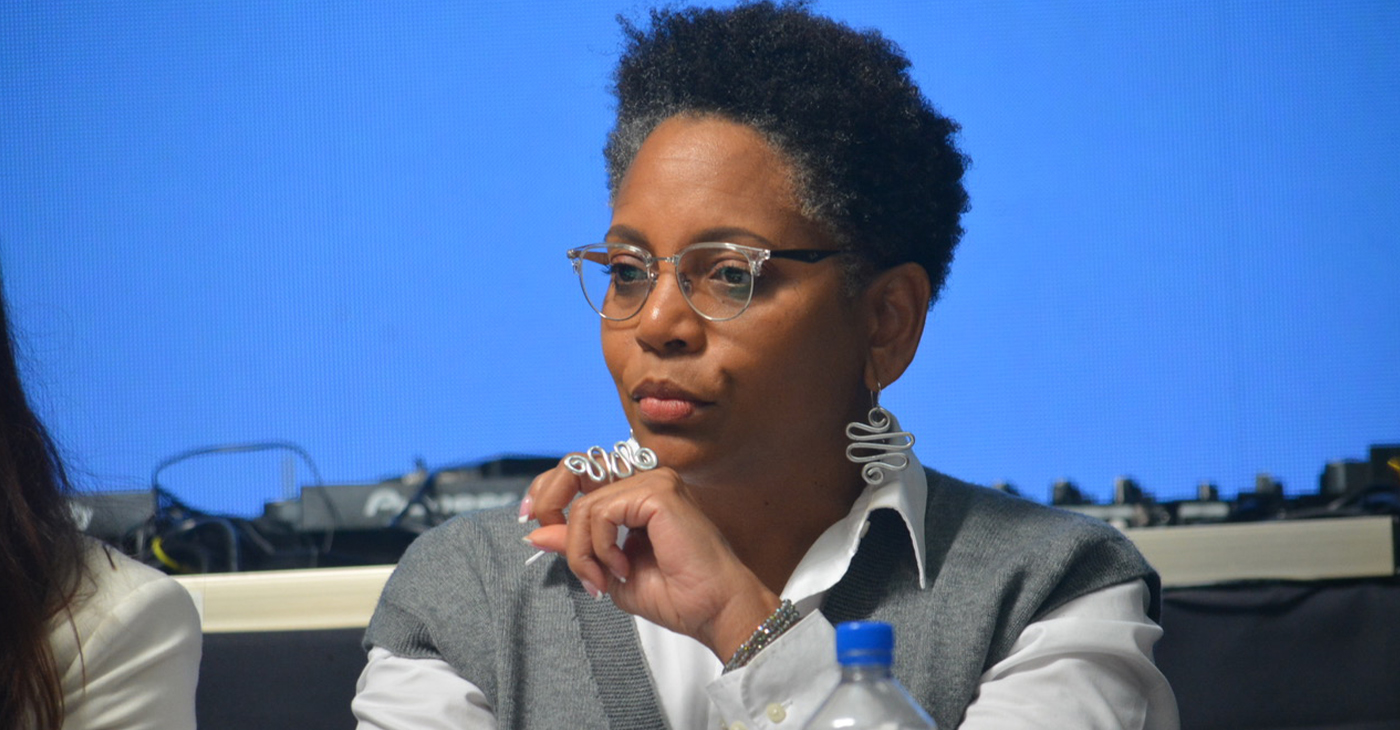
By Antonio Ray Harvey, California Black Media
The Community Housing Working Group hosted a briefing on April 23 at Cafeteria 15L in Sacramento. Discussions focused on how the housing crisis in California affects Black and Brown communities and explored ways to provide low-income families and individuals with affordable housing.
Tia Boatman Patterson, CEO and President of the California Communities Reinvestment Corporation, said “entry-level housing” is not available as it was in the past, adding that affordable units were a major point of entry into homeownership for many families in the Black community.
“My mother bought her first house when I was in junior high. It was an 850-square foot, two-bedroom and one-bathroom house in 1978. That house cost $30,000,” Boatman-Patterson said.
“A woman working part-time at JCPenney was able to afford that house. We don’t build these types of housing now. We do not build entry-level homeownership,” she added.
The Community Housing Working Group is a collection of diverse community organizations from across California working together to address housing challenges in their communities. The organization believes that solving the affordable housing crisis will require creating enough smaller, lower-cost, multi-family homes located near jobs, transit, and good schools.
The briefing included a panel discussion titled, “Exclusionary Zoning: A Look Back and a Path Forward.” Boatman-Patterson participated in that session along with Henry “Hank” Levy, Treasurer-Tax Collector for Alameda County, and Noerena Limón, consultant, Unidos U.S., and Board Member of California Housing Finance Agency.
Boatman-Patterson, a former Associate Director for Housing, Treasury and Commerce in the Office of Management and Budget for the Biden Administration, started her presentation by highlighting how exclusionary single-family zoning is contributing to continued segregation of California communities.
She said that single-family zoning originated in the Bay Area city of Berkeley in 1916.
“By creating single-family zoning and having fenced-off communities, you were able to exclude the ‘others,’” Boatman-Patterson said. “It really was a method to exclude — what they called ‘economic segregation’ — but that was a guise for racial segregation. Single-family zoning, along with redlining, became a systemic approach to exclude based on affordability.”
Title VIII of the federal Civil Rights Act of 1968 — commonly known as the Fair Housing Act of 1968 – is the U.S. federal legislation that protects individuals and families from discrimination in the sale, rental, and financing of housing. It was passed to open the doors to affordable housing.
In 1968, 65.9% of White families were homeowners, a rate that was 25% higher than the 41.1% of Black families that owned their homes, according to National Low-Income Housing Coalition. Today, those figures have hardly changed in the Black community, although White homeownership has increased five percentage points to 71.1%.
Boatman Patterson said the rate has not changed in Black and Brown communities because financing for affordable entry-level homes is almost nonexistent. The homeownership disparities contribute to the disturbing racial wealth gap in the nation, according to the National Low-Income Housing Coalition’s October 2018 report.
“We really must align the financing with the actual building of units, which we haven’t necessarily done. Because of this misalignment, I think we continue to see problems,” Boatman-Patterson said.
California Black Media
State Ed Chief Tony Thurmond Pushes Bill to Train Educators
State Superintendent of Public Instruction (SSPI) Tony Thurmond is advocating for comprehensive training for teachers in reading and math, emphasizing the urgent need to improve student academic outcomes across California. On April 24, during testimony in the Senate Education Committee, Thurmond backed Senate Bill (SB)1115, which aims to provide evidence-backed educator training. The committee passed the bill with a 7-0 vote.
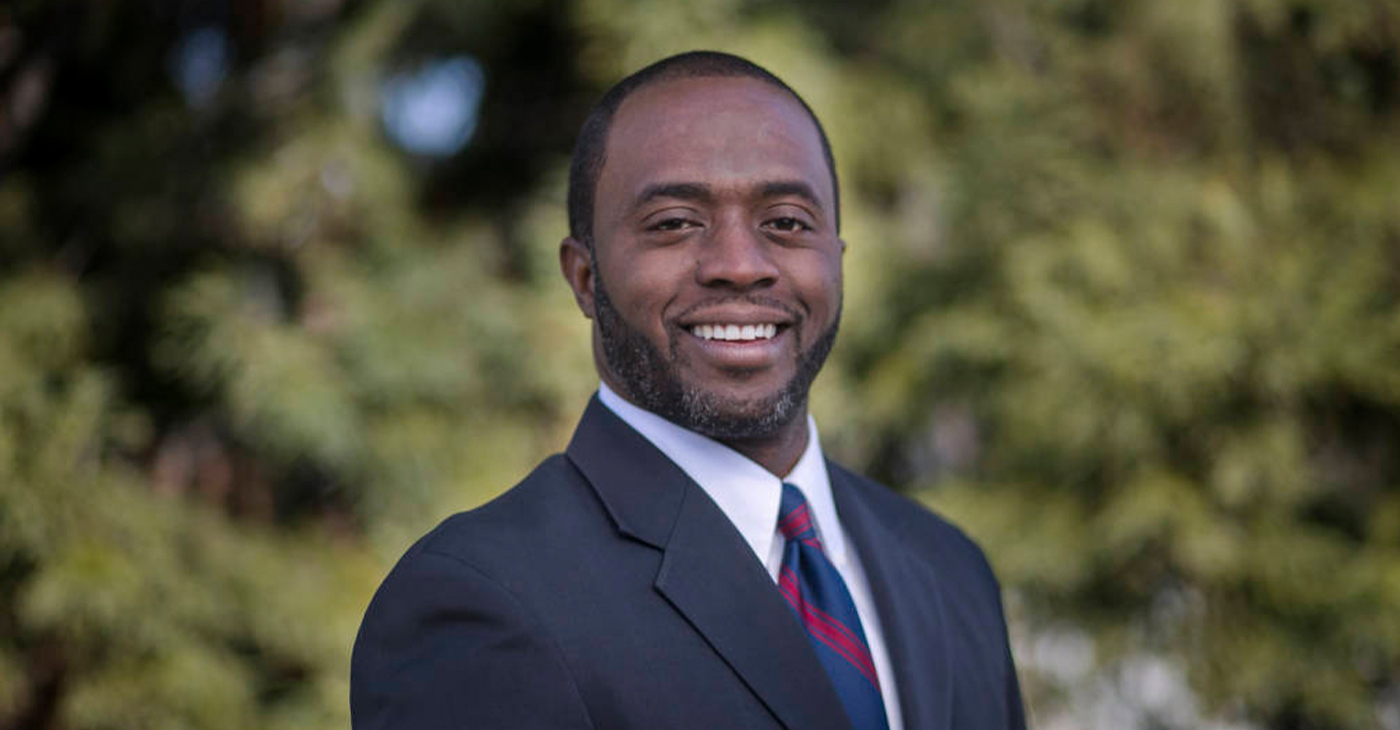
By California Black Media
State Superintendent of Public Instruction (SSPI) Tony Thurmond is advocating for comprehensive training for teachers in reading and math, emphasizing the urgent need to improve student academic outcomes across California.
On April 24, during testimony in the Senate Education Committee, Thurmond backed Senate Bill (SB)1115, which aims to provide evidence-backed educator training. The committee passed the bill with a 7-0 vote.
Thurmond pointed out to the committee that existing funding for educator training in literacy and math only covers about one-third of California’s educator workforce. SB 1115, Thurmond said, would fund the remaining two-thirds.
“This is an issue of moral clarity,” according to Thurmond. “In the fifth-largest economy in the world, and in an age when we have access to substantial brain science about how students learn, it should be unacceptable to train only some educators in the best strategies to teach essential skills.”
SB 1115 incorporates multiple research-backed methods, including phonics, and it aligns with the California ELA/ELD Framework, which encourages biliteracy and multilingualism.
Thurmond emphasized the moral imperative behind the push for enhanced training by noting that 70% of incarcerated adults struggle with reading or are illiterate.
“Every child should feel supported as they learn to read and every teacher should feel confident in their ability to support students’ foundational literacy,” Thurmond said. “SB 1115 is about ensuring that all children have the opportunity to read by third grade, and that all children have a shot at the life-changing outcomes that come from early literacy.”
The next step for SB 1115 is a hearing in the Senate Appropriations Committee on May 6.
-

 Community3 weeks ago
Community3 weeks agoFinancial Assistance Bill for Descendants of Enslaved Persons to Help Them Purchase, Own, or Maintain a Home
-

 City Government5 days ago
City Government5 days agoCourt Throws Out Law That Allowed Californians to Build Duplexes, Triplexes and RDUs on Their Properties
-

 Business3 weeks ago
Business3 weeks agoV.P. Kamala Harris: Americans With Criminal Records Will Soon Be Eligible for SBA Loans
-

 Activism2 weeks ago
Activism2 weeks agoOakland Post: Week of April 24 – 30, 2024
-

 Activism4 weeks ago
Activism4 weeks agoOakland Post: Week of April 10 – 16, 2024
-

 Community3 weeks ago
Community3 weeks agoAG Bonta Says Oakland School Leaders Should Comply with State Laws to Avoid ‘Disparate Harm’ When Closing or Merging Schools
-

 Community3 weeks ago
Community3 weeks agoRichmond Nonprofit Helps Ex-Felons Get Back on Their Feet
-

 Community3 weeks ago
Community3 weeks agoOakland WNBA Player to be Inducted Into Hall of Fame

